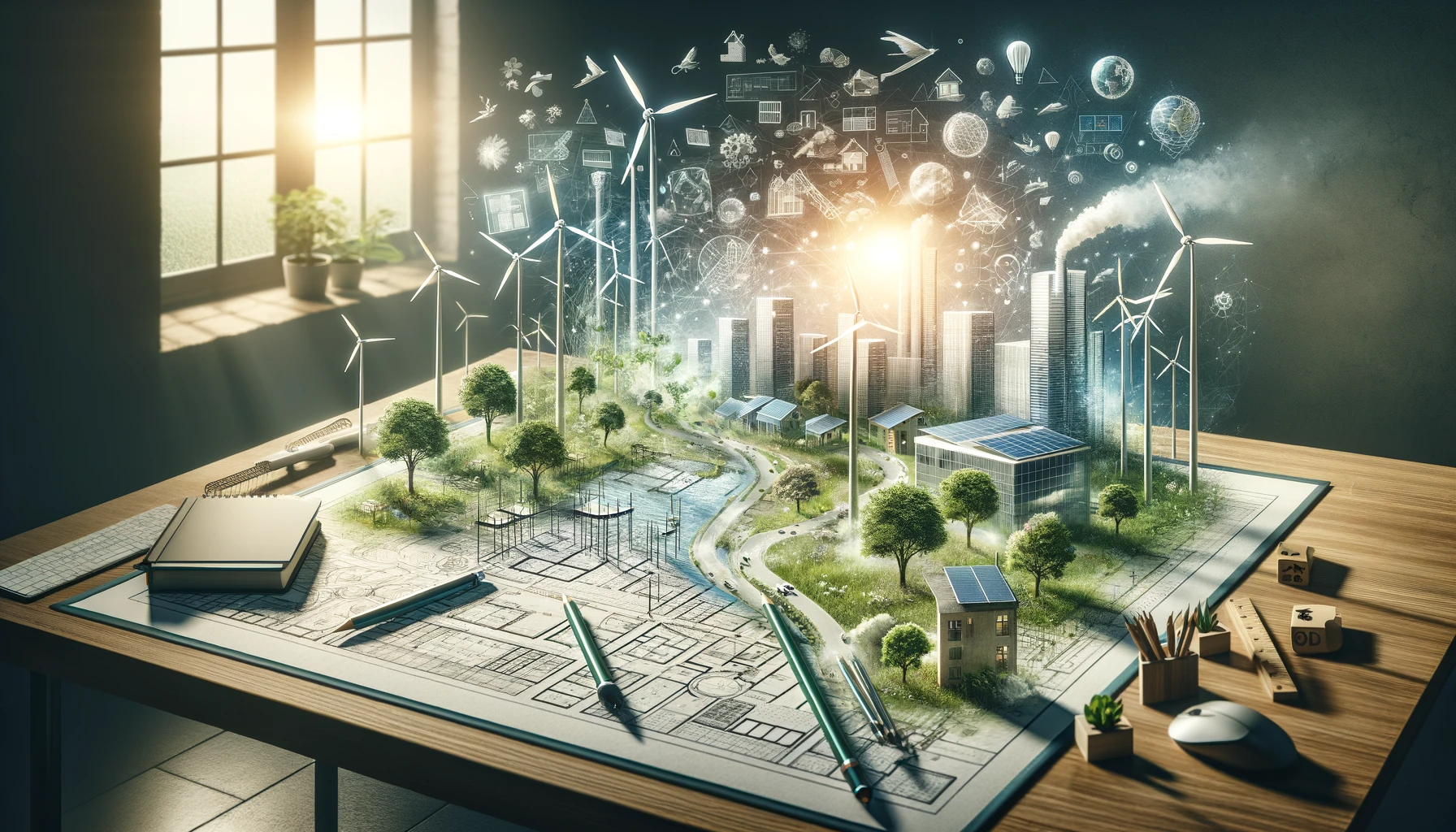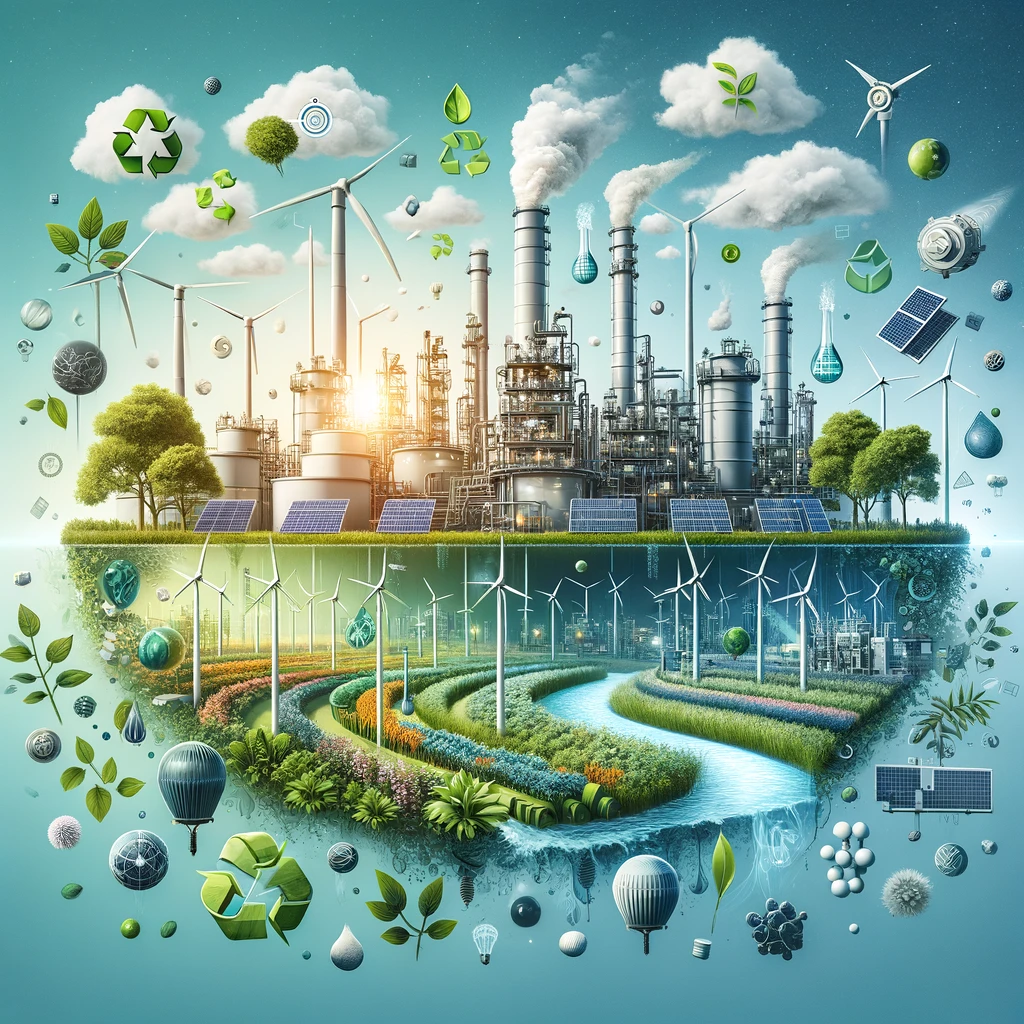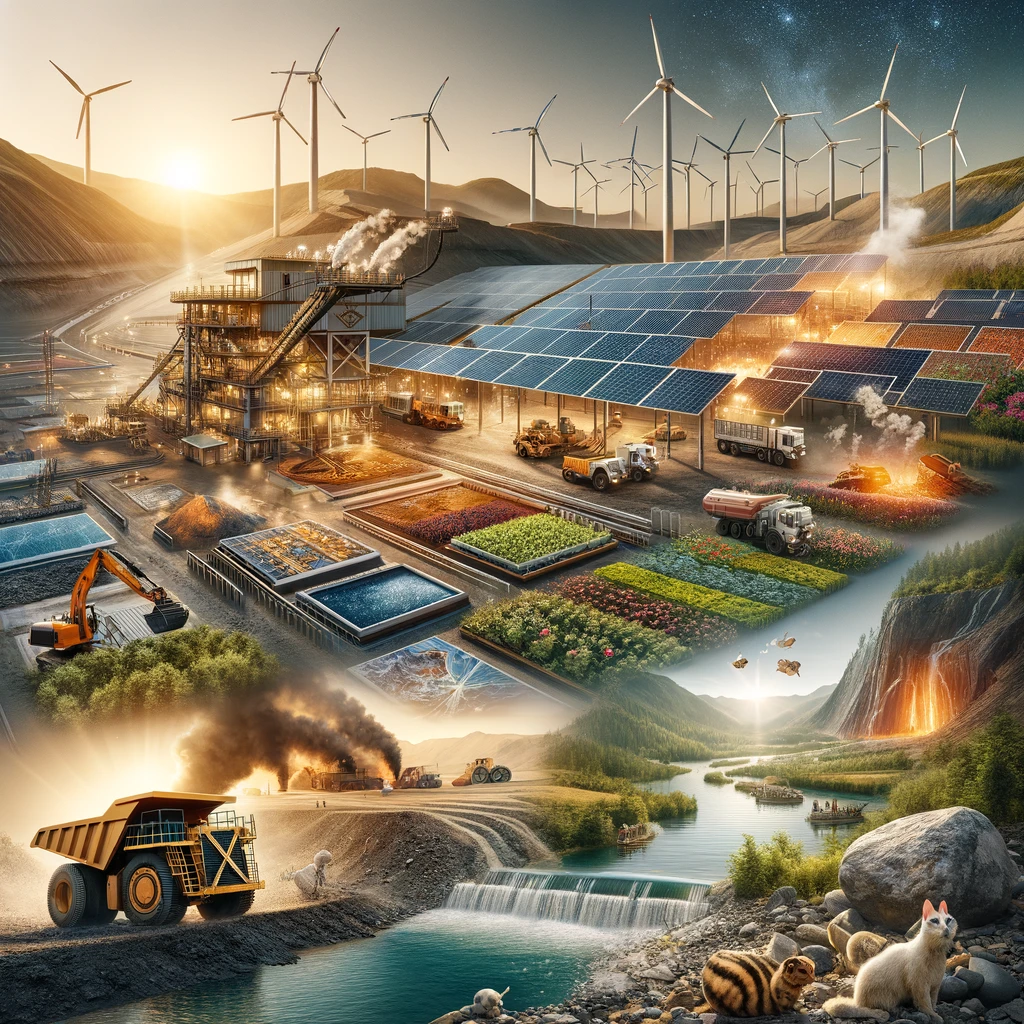
GIRHIMPROM's blueprint for a Greener Future
In an era defined by the urgent call for climate action, the momentum toward industrial decarbonization has escalated into a global imperative. Industries historically anchored in practices with substantial carbon footprints—chemical, construction, and mining—are now at the forefront of an evolutionary shift. This transformation, driven by innovation and a steadfast commitment to sustainability, positions these sectors as pioneers on the path to a greener future. As we delve into the nuanced strategies and practices shaping this journey, it becomes evident that the balance between industrial growth and environmental stewardship is not just possible—it’s within reach.
The Chemical Industry: Catalysts of Environmental Innovation
Within the vast tapestry of global industries, the chemical sector emerges as both a cornerstone and a conduit of progress, touching every aspect of modern life—from the food we eat to the medicines that heal us. Its omnipresence, however, comes with a significant environmental footprint, primarily due to its long-standing dependence on fossil fuels. Today, as the world pivots toward sustainability, the chemical industry finds itself at a crossroads, challenged to reimagine its processes and practices not just for efficiency and profit, but for the planet.
The Drive for Energy Efficiency: A Multifaceted Approach
Embarking on the journey toward sustainability, the industry has identified energy efficiency as a critical battleground. The path forward involves a multifaceted approach that blends technological innovation with process improvement. Upgrading facilities with cutting-edge technology not only enhances operational efficiency but also significantly reduces energy consumption and emissions. Advanced thermal management and process optimization further streamline operations, minimizing energy waste and slashing operational costs. Together, these strategies form a blueprint for a more sustainable, cost-effective future in chemical manufacturing.
Embracing Renewable Energy: Towards Cleaner Chemical Processes
The transition to renewable energy sources stands as a pivotal moment in the industry’s history. This shift is not merely about adopting greener power sources; it’s about fundamentally transforming how chemical processes are powered. Solar and wind energy, once seen as peripheral to industrial applications, are now central to the industry’s vision of a cleaner future. Solar thermal systems and wind-powered electrolysis, for example, offer a glimpse into a future where chemical production harmonizes with the environment, leveraging the power of nature to drive reactions and processes without the carbon footprint associated with traditional energy sources.
Advancing CCUS: A Vision for a Circular Carbon Economy
Carbon Capture, Utilization, and Storage (CCUS) technologies have emerged as a game-changer, symbolizing a significant leap towards the industry’s decarbonization goals. Far beyond the simple reduction of emissions, CCUS embodies a bold vision for a circular carbon economy. By capturing carbon dioxide emissions at their source and converting them into valuable products, the industry can transform a potential environmental liability into a suite of assets. From fertilizers to novel materials, the possibilities are vast, turning the tide on carbon emissions and paving the way for a new era of industrial symbiosis.
Pioneering Sustainable Materials: The Shift to Bio-based and Recycled Feedstocks
Perhaps one of the most transformative shifts in the industry is the move towards bio-based and recycled feedstocks. This strategic pivot not only mitigates the industry’s reliance on fossil fuels but also ushers in a new age of material innovation. By harnessing the power of bio-based materials and recycling waste into new products, the chemical sector is redefining its impact on the environment and society. This approach not only reduces the carbon footprint of chemical production but also stimulates innovation, opening up new pathways for sustainable development and reinforcing the industry’s role as a catalyst for change.

Constructing a Sustainable Future: Reimagining the Built Environment

The construction industry, a cornerstone of human progress and an architect of civilizations, finds itself at a pivotal juncture. Tasked with a formidable challenge in the modern era—the battle against climate change—this age-old industry is undergoing a renaissance, reinventing itself to forge a sustainable future. This transformation is rooted in a fundamental shift towards sustainability, where the adoption of innovative materials and practices heralds a new dawn for construction, one that harmonizes with the planet rather than working against it.
The Foundation of Sustainability: Choosing the Right Materials
At the heart of this transformation is a strategic pivot towards sustainable materials. Low-carbon cement, for instance, represents a revolution in traditional construction methodologies, significantly reducing the carbon footprint associated with concrete, the most widely used building material in the world. Similarly, sustainably sourced timber emerges as not just an environmentally friendly alternative but a beacon of hope for reducing deforestation and promoting reforestation. These materials, along with other green alternatives, are not merely substitutions; they are enhancements, promising improved performance, durability, and, importantly, a path towards a greener planet.
Redefining Aesthetics: The Art of Energy-Efficient Design
The evolution of the construction industry also reflects a profound reimagining of architectural aesthetics, where the beauty of a building is matched by its sustainability. Energy-efficient design principles are at the forefront of this shift, focusing on the integration of natural elements and innovative technologies to create buildings that are not just spaces but ecosystems. Natural lighting, once a mere design choice, is now a strategic element that reduces the need for artificial lighting, while superior insulation materials and techniques ensure that buildings maintain their internal temperatures with minimal energy use. Passive solar heating, a concept as old as architecture itself, is being rediscovered and refined, harnessing the sun’s power to provide natural warmth, reducing reliance on fossil fuels for heating.
Green Construction Practices: Building Responsibly
The industry’s commitment to a sustainable future is further evidenced by the embrace of green construction practices. The quest for carbon-neutral sites is transforming construction sites around the globe, where waste minimization strategies and recycling initiatives are becoming the norm rather than the exception. The adoption of electric and hydrogen-powered machinery marks a significant departure from traditional diesel-powered equipment, reducing emissions and paving the way for cleaner, more sustainable construction processes.
This shift towards green construction is not just about reducing the environmental impact of building projects; it’s about redefining what it means to build. It signifies a deeper understanding of the construction industry’s role in society—not merely as builders of structures but as custodians of the environment and contributors to the well-being of future generations.
The Mining Industry: Unearthing a Path to Sustainability
As the bedrock upon which the global economy is built, the mining sector confronts unparalleled scrutiny regarding its environmental footprint. Historically, this industry has been synonymous with intensive energy use and significant ecological disruption. However, a paradigm shift is underway, marked by an ambitious drive towards sustainability. This transformation is propelled by innovative practices and technologies that aim to harmonize the sector’s economic contributions with its environmental responsibilities.
Embracing Electrification: A Leap Towards Green Mining
The transition towards electric mining operations emerges as a pivotal strategy in the quest to mitigate the industry’s environmental impact. This move away from diesel-powered machinery to electric alternatives represents a significant leap forward, offering a dual benefit: a substantial reduction in greenhouse gas emissions and a decrease in air pollutants that affect the health of workers and surrounding communities. Electric vehicles and equipment not only operate more quietly but also more efficiently, reducing the energy expenditure associated with extraction and processing activities.
Harnessing Renewable Energy: Powering Operations Sustainably
The integration of renewable energy sources into mining operations marks a critical step towards sustainability. Solar-powered pumps and wind-powered ventilation systems exemplify how the sector can leverage nature’s bounty to meet its energy needs. These initiatives do more than just shrink the carbon footprint of mining activities; they also bolster energy security and resilience, particularly in remote locations where access to traditional power grids is often challenging and costly. By investing in solar arrays, wind farms, and even geothermal energy where feasible, mining companies can ensure a more stable and sustainable energy supply.
Streamlining Efficiency: The Core of Sustainable Extraction
Central to sustainable mining practices is the drive for efficiency improvements across all facets of operations. Advanced technologies, including automation and real-time data analytics, play a crucial role in optimizing extraction processes, minimizing waste, and conserving water. By implementing precision drilling and ore-grade analysis, mines can target rich deposits more accurately, thereby reducing the volume of material processed and the associated energy consumption. These efficiency gains not only enhance environmental performance but also improve the bottom line, showcasing sustainability as a pathway to economic viability.
Committing to Rehabilitation: Restoring Nature’s Balance
Mine rehabilitation represents the industry’s pledge to environmental stewardship, emphasizing the restoration of ecosystems post-extraction. This commitment extends beyond the mere replanting of native flora; it encompasses comprehensive efforts to rebuild habitats for wildlife, replenish water sources, and stabilize landscapes to prevent erosion. By rehabilitating mining sites, the sector can ensure that its legacy is not defined by extracted minerals alone but also by the restoration of natural landscapes to their former glory or even improved conditions.
Such initiatives reflect a broader understanding within the industry that true sustainability involves a cyclical relationship with the environment. Through progressive rehabilitation plans and ongoing monitoring, mining operations can leave behind a positive environmental legacy, contributing to biodiversity and supporting the needs of future generations.

A Unified Vision for the Future
In the midst of a global awakening to the urgent need for climate action, the path to industrial decarbonization unfolds as a multifaceted journey, laden with both challenges and boundless opportunities. This journey demands a collaborative spirit that transcends sectors, borders, and ideologies, embodying a narrative of profound transformation. It is here, within this narrative, that GIRHIMPROM stands as a beacon of innovation and sustainability, guided by the twin pillars of digital innovation and circular economy principles. Our mission? To not only mitigate the impacts of industrial activities but to fundamentally redefine their essence, cultivating a model of operation where waste is minimized, resources are maximized, and sustainability is embedded in every facet of our work.
GIRHIMPROM’s call to action echoes with a profound sense of urgency, inviting industries, governments, and communities to unite under the noble banner of environmental stewardship. We champion the conviction that industrial excellence and environmental responsibility are not conflicting goals but are instead complementary facets of a modern, resilient, and sustainable economy. Our ethos of collaboration is a testament to our belief that the journey toward sustainability is best traveled together, through shared ambition and collective action.
As we stand at a pivotal moment in our collective history, the decisions we make today will indelibly shape the legacy we leave for the generations to come. The strategies and initiatives championed by GIRHIMPROM go beyond mere operational enhancements or emissions reductions; they represent a holistic vision for a sustainable industrial landscape. In this vision, sectors like chemical, construction, and mining do not merely adapt to a new era but actively shape it, demonstrating that harmonious economic growth and environmental preservation are not only possible—they are imperative.
The road ahead is strewn with obstacles, yet it is also ripe with unparalleled opportunities for innovation, leadership, and transformative change. This pivotal moment offers industries the chance to reimagine their legacy—not merely as builders, makers, and extractors but as pioneers of a sustainable and equitable future. By embracing this mantle, GIRHIMPROM and its partners contribute far more than reduced emissions or greener products; together, we are laying the foundation for a world that cherishes resilience, equity, and prosperity for all its inhabitants.
This transformation is more than a responsibility; it is a global imperative to innovate, lead, and inspire across the vast tapestry of human endeavor. As GIRHIMPROM steps forward to lead this monumental shift, our actions illuminate the path for others, heralding a healthier, fairer, and more prosperous planet for everyone. The journey towards a sustainable industrial landscape is indeed complex and uncharted, but armed with a unified vision and a collective will, the path to a greener, more equitable future is not just a possibility—it is a certainty.
We invite you to join us in this critical mission. Discover how GIRHIMPROM’s design services and expertise in sustainable industry practices can revolutionize your operations and contribute to a greener planet. Visit our website and reach out through our request a quote page to learn how together, we can forge a sustainable tomorrow.
